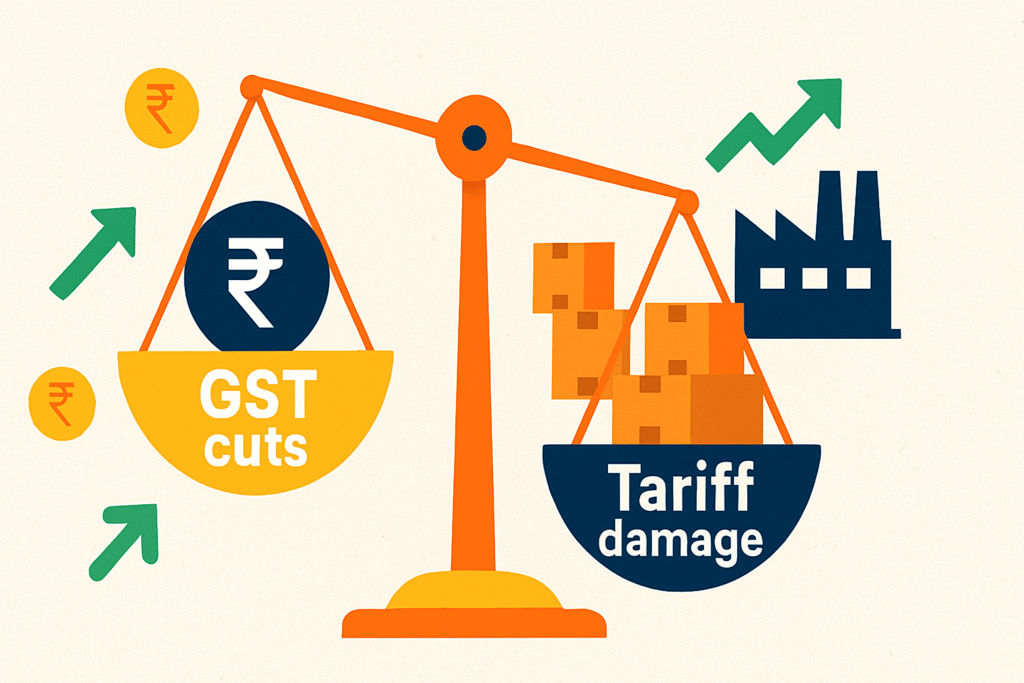India’s economy is navigating a challenging phase as steep tariffs imposed by the United States on Indian exports have disrupted trade flows and pressured exporters. In response, the Indian government has implemented targeted Goods and Services Tax (GST) cuts and tax reforms to mitigate the adverse effects of tariffs. But how effective are these fiscal measures in offsetting tariff damage and sustaining economic growth? This blog post explores the impact of India’s GST cuts and tax policies in the context of current global trade dynamics.
The Tariff Impact on Indian Exports
The US recently doubled tariffs on a wide range of Indian goods to 50%, affecting sectors like textiles, gems, jewelry, machinery, and more. These tariffs have increased the cost of Indian exports in international markets, threatening demand and profitability. Exporters face higher price barriers, making it harder to compete globally, especially in the US market—a key destination for Indian goods.
GST Cuts: Stimulating Domestic Demand and Reducing Costs
To counter the export shock, India’s government slashed GST rates on hundreds of consumer products and industrial inputs. These cuts aim to stimulate domestic consumption, which constitutes approximately 60% of India’s GDP, by making goods more affordable for consumers. Higher domestic demand can partially compensate for export losses by fueling internal economic activity.
Additionally, GST reductions lower production costs for manufacturers and exporters by reducing taxes on raw materials and intermediate goods. This cost advantage helps companies maintain more competitive pricing internationally despite the added tariff burden.
Evaluating the Effectiveness of Tax Measures
Emerging analyses indicate that GST cuts and tax relief measures contribute positively to India’s economic resilience:
- GDP Growth Support: Experts estimate these reforms add between 0.3% to 1.2% to GDP growth in coming quarters, helping offset the estimated negative impact of tariffs on economic expansion.
- Business Competitiveness: Reduced tax rates lower operational expenses, supporting exporters in maintaining viable price points.
- Fiscal Balance: Although tax cuts entail revenue loss, increased compliance and economic activity may balance the fiscal impact.
- Inflation Control: Lower GST rates ease inflationary pressures, aiding consumer purchasing power and confidence.
Despite these benefits, GST cuts alone cannot fully neutralize the extensive impact of tariffs. Exporters must simultaneously adopt strategies like market diversification and product innovation to fully overcome trade barriers.
Complementing Policies and Longer-Term Outlook
India is also focusing on trade negotiations, export incentives, and currency management to further counter tariff effects. Improved supply chain efficiency and technological adoption complement tax measures, helping businesses adapt to shifting global trade environments.
As global trade tensions persist, India’s integrated approach combining GST reforms and other economic policies positions the country to maintain steady growth and exporter competitiveness.
Conclusion
India’s GST cuts and tax reform measures represent a vital component of the country’s strategy to mitigate tariff damage. By boosting domestic demand, lowering production costs, and supporting exporters’ competitiveness, these fiscal policies help cushion the economic blow from international tariffs. However, for sustained success, these measures must be part of a broader framework that includes market adaptation and policy innovation.
Indian businesses and policymakers alike can leverage these insights to navigate current trade challenges and create a resilient economic future.

